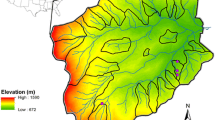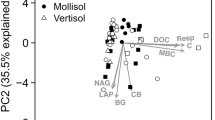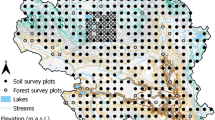Abstract
Carbon pools and fluxes were quantified along an environmentalgradient in northern Arizona. Data are presented on vegetation, litter, andsoil C pools and soil CO2 fluxesfrom ecosystems ranging from shrub-steppe through woodlands to coniferousforest and the ecotones in between. Carbon pool sizes and fluxes in thesesemiarid ecosystems vary with temperature and precipitation and are stronglyinfluenced by canopy cover. Ecosystem respiration is approximately 50percent greater in the more mesic, forest environment than in the dryshrub-steppe environment. Soil respiration rates within a site varyseasonally with temperature but appear to be constrained by low soilmoisture during dry summer months, when approximately 75% of totalannual soil respiration occurs. Total annual amount of CO2 respired across all sites ispositively correlated with annual precipitation and negatively correlatedwith temperature. Results suggest that changes in the amount and periodicityof precipitation will have a greater effect on C pools and fluxes than willchanges in temperature in the semiarid Southwestern United States.
Similar content being viewed by others
References
Anderson JM (1991) The effects of climate change on decomposition processes in grassland and coniferous forests. Ecol. Apps. 1: 326–347
Baker FS (1944) Mountain climates of the western United States. Ecol. Monogr. 14: 225–254
Bottner P (1985) Responses of microbial biomass to alternate moist and dry conditions in a soil incubated with 14C and 15N labelled plant material. Soil Biol. Biochem. 17: 329–337
Caldwell MM, White RS, Moore RT & Camp LB (1977) Carbon balance, productivity, and water use of cold-winter desert scrub communities dominated by C3 and C4 species. Oecologia 29: 275–300
Cochran WG (1977) Sampling Techniques. John Wiley and Sons, New York
DeLucia EH, Callaway RM & Schlesinger WH (1994) Offsetting changes in biomass allocation and photosynthesis in ponderosa pine (Pinus ponderosa) in response to climate change. Tree Phys. 14: 669–677
Douglas, J (1995) Global climate research: Informing the decision. EPRI Journal 20: 6–15
Emanuel WR, Shugart HH & Stevenson MP (1985) Climatic change and the broadscale distribution of terrestrial ecosystem complexes. Climatic Change 7: 29–43
Fisher FM, Parker LW, Anderson JP & Whitford WG (1987) Nitrogen mineralization in a desert soil: Interacting effects of soil moisture and nitrogen fertilizer. Soil Sci. Soc. Am. J. 51: 1033–1041
Freijer JI & Bouton W (1991) A comparison of field methods for measuring soil carbon dioxide evolution: Experiments and simulation. Plant and Soil 135: 133–142
Fulé PZ, Covington WW & Moore MM (1997) Determining reference conditions for ecosystem management of southwestern ponderosa pine forests. Soil Sci. Soc. Am. J. 7: 895–908
Grier CC, Elliot KJ & McCullough DG (1992) Biomass distribution and productivity of Pinus edulis-Juniperus monosperma woodlands of north-central Arizona. For. Ecol. Manage. 50: 331–350
Hanson CL (1982) Distribution and stochastic generation of annual and monthly precipitation on a mountainous watershed in southwest Idaho. Water Res. Bull. 18: 875–883
Holt JA (1987) Carbon mineralization in semi-arid northeastern Australia: The role of termites. J. Trop. Ecol. 3: 255–263
Houghton JT (1996) Climate Change 1995: The Science of Climate Change. Cambridge University Press, New York
Hungerford RD, Nemani RR, Running SW & Coughlan JC (1989) MTCLIM: A Mountain Microclimate Simulation Model. USDA Forest Service, Intermountain Research Station, Ogden, UT
Jenkinson DS, Adams DE & Wild A (1991) Model estimates of CO2 emissions from soil in response to global warming. Nature 351: 304–306
Klemmedson JO (1975) Nitrogen and carbon regimes in an ecosystem of young, dense ponderosa pine in Arizona. Forest Science 21: 163–168
Klopatek JM (1987) Nitrogenmineralization and nitrification in mineral soils of pinyon-juniper ecosystems. Soil Sci. Soc. Am. J. 51: 453–457
Klopatek JM, Conant RT, King JM, Malin RC, Murphy KL & Klopatek CC (1998) Implications of spatial and temporal patterns of carbon flux across a semiarid ecotone. Landscape and Urban Planning (in press)
Klopatek CC, Murphy KL & Klopatek JM (1995) Preliminary Results of Carbon Cycling in Southwestern Ecosystems: Implications for Climate Change. USDA Forest Service, Fort Collins, CO
McDaniel PA & Graham RC (1992) Organic carbon distributions in shallow soils of pinyon-juniper woodlands. Soil Sci. Soc. Am. J. 56: 499–504
Murphy, KL, Klopatek CC & Klopatek JM (1998) The effects of litter quality and climate on litter decomposition along an elevational gradient in northern Arizona. Ecological Applications (in press)
Nay SM, Mattson KG & Bormann BT (1994) Biases of chamber methods for measuring soil CO2 efflux demonstrated with a laboratory apparatus. Ecology 75: 2460–2463
Neilson RP, King GA, Lenihan J & DeVelice RL (1990) The annual course of precipitation over much of the United States: Observed versus GCM simulation. In: Betancourt JL & MacKay AM (Eds) Sixth Annual Pacific Climate (PACLIM) Workshop (pp 19–26). California Department of Water Resources, Interagency Ecological Studies Program
Nelson DW & Sommers LE (1982) Total carbon, organic carbon, and organic matter. In: Page AL (Ed) Methods of Soil Analysis Part 2 (pp 539–579). Soil Science Society of America, Madison, Wisconsin
Ojima DS, Parton WJ, Schimel DS, Scurlock JM & Kittel TGF (1993) Modeling the effects of climatic and CO2 induced changes on grassland storage of soil C. Water, Air, and Soil Pollution 70: 643–657
Parton WJ, Ojima DS, Cole CV & Schimel DS (1994) A general model for soil organic matter dynamics: Sensitivity to litter chemistry, texture andmanagement. In: Bryant RB & Arnold RW (Eds) Quantitative Modeling of Soil Forming Processes (pp 147–167). Soil Science Society of America, Madison, WI
Pastor J & Post WM (1988) Response of northern forests to CO2induced climate change. Nature 334: 55–58
Paul EA & Clark FE (1989) Soil Microbiology and Biochemistry. Academic Press, San Diego
Post WM (1993) Uncertainties in the terrestrial carbon cycle. In: Solomon AM & Shugart HH (Eds) Vegetation Dynamics and Global Change (pp 116–132). Chapman Hall, New York
Raich JW & Schlesinger WH (1992) The global carbon dioxide flux in soil respiration and its relationship to vegetation and climate. Tellus 44B: 81–99
Richards BN (1987) The Microbiology of Terrestrial Ecosystems. Longman Scientific, Burnt Mill, UK
Rowlands PG (1993) Climatic factors and the distribution of woodland vegetation in the Southwest. The Southwestern Naturalist 38: 185–197
SAS (1985) SAS User's Guide: Statistics Version 5 Edition. SAS Institute Inc. Cary, NC
Schimel DS (1995) Terrestrial ecosystems and the carbon cycle. Global Change Biology 1: 77–91
Schlentner RE & Van Cleve K (1985) Relationships between carbon dioxide evolution from soil, substrate temperature and substrate moisture in 4 mature forest types in interior Alaska (USA). Canadian Journal of Forest Research 15: 97–106
Schleser GH (1982) The response of CO2 evolution of soils to global temperature change. Zeitschrift für Naturforschung 37a: 287–291
Schlesinger WH (1991) Biogeochemistry: An Analysis of Global Change. Academic Press, San Diego
Schlesinger WH (1977) Carbon balance in terrestrial detritus. Annual Review of Ecology and Systematics 8: 51–81
Schlesinger WH, Reynolds JF, Cunningham GL, Huenneke LF, Jarrell WM, Virginia RA & Whitford WG (1990) Biological feedbacks in global desertification. Science 247: 1043–1048
Schlesinger WH, Raikes JA, Hartley AE & Cross AF (1996) On the spatial pattern of soil nutrients in desert ecosystems. Ecology 77: 364–374
Schneider S (1995) Scenarios of global warming. In: Kareiva PM, Kingsolver JG & Huey RB (Eds) Biotic Interactions and Global Change (pp 9–23). Sinauer, Sunderford, MA
Toure B (1995) Soil Moisture and Moisture of C3 and C4 Grasses Along an Environmental Gradient. MS Thesis. Department of Botany. Arizona State University. Tempe, AZ
Townsend AR, Vitousek PM & Holland EA (1992) Tropical soils could dominate the short-term carbon cycle feedbacks to increased global temperatures. Climatic Change 22: 293–303
Van Cleve K, Oechel WC & Hom JL (1990) Response of black spruce (Picea mariana) ecosystems to soil temperature modification in interior Alaska. Can. J. For. Res. 20: 1530–1535
Washington WM & Meehl GA (1989) Climate sensitivity due to increased CO2: Experiments with a coupled atmosphere and ocean general circulation model. Climate Dynamics 4: 1–38
Wildung RE, Garland TR & Buschbom RL (1975) The interdependent effects of soil temperature andwater content in soil respiration rate and plant root decomposition in arid grassland soils. Soil Biol. Biochem. 7: 373–378
Author information
Authors and Affiliations
Rights and permissions
About this article
Cite this article
Conant, R.T., Klopatek, J.M., Malin, R.C. et al. Carbon pools and fluxes along an environmental gradient in northern Arizona. Biogeochemistry 43, 43–61 (1998). https://doi.org/10.1023/A:1006004110637
Issue Date:
DOI: https://doi.org/10.1023/A:1006004110637




